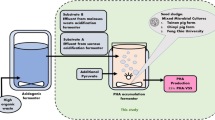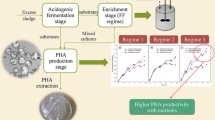Abstract
The aim of the study was to investigate the use of dark fermented paperboard mill wastewater (PMW) containing volatile fatty acids for polyhydroxyalkanoates (PHA) production. Six sequencing batch reactors (SBRs) were initially fed with synthetic feed containing acetate and operated at different organic loading rates (OLRs) of 0.5, 1.0, 1.5, 2.0, 2.5, and 3.0 gCOD l−1 day−1 for PHA-storing bacteria enrichment. The maximum PHA content and yield (Y PHA/S) were 67.44 ± 5.88 % and 0.45 ± 0.39 C-mol C-mol−1 at OLR of 1.5 gCOD l−1 day−1, respectively. The synthetic feed was replaced by dark fermented PMW effluent rich in acetate, butyrate, propionate, and lactate at the accumulation stage resulting in a PHA content and yield of 58.57 ± 4.02 % and 0.46 ± 0.09 C-mol C-mol−1, respectively. The maximum specific PHA production rate (q maxPHA ) amounted to 0.29 ± 0.1 C-mol C-mol−1 X−1 h−1. Illumina MiSeq sequencing of bacterial 16S rRNA gene showed that Proteobacteria and Bacteroidetes increased from 37.4 to 77.6 % and from 2.49 to 17.66 % at enrichment and accumulation stages, respectively. Actinobacteria (15.44 %), Chloroflexi (8.15 %), Planctomycetes (7.46 %), and Acidobacteria (6.0 %) were detected at the enrichment SBRs.
Graphical Abstract









Similar content being viewed by others
References
Albuquerque MGE, Concas S, Bengtsson S, Reis MAM (2010a) Mixed culture polyhydroxyalkanoates production from sugar molasses: the use of a 2-stage CSTR system for culture selection. Bioresour Technol 101:7112–7122. doi:10.1016/j.biortech.2010.04.019
Albuquerque MGE, Torres CV, Reis MM (2010b) Polyhydroxyalkanoate (PHA) production by a mixed microbial culture using sugar molasses: effect of the influent substrate concentration on culture selection. Water Res 44:3419–3433. doi:10.1016/j.watres.2010.03.021
Al-Shorgani NKN, Tibin EM, Ali E et al (2014) Biohydrogen production from agroindustrial wastes via Clostridium saccharoperbutylacetonicum N1-4 (ATCC 13564). Clean Technol Environ Policy 16:11–21. doi:10.1007/s10098-013-0586-6
APHA (2005) Standard methods for the examination of water and wastewater, 25th edn. APHA, Washington, DC
Basri MF, Yacob S, Hassan M et al (2009) Improved biogas production from palm oil mill effluent by a scaled-down anaerobic treatment process. World J Microbiol Biotechnol 26:505–514. doi:10.1007/s11274-009-0197-x
Bengtsson S, Werker A, Christensson M, Welander T (2008) Production of polyhydroxyalkanoates by activated sludge treating a paper mill wastewater. Bioresour Technol 99:509–516. doi:10.1016/j.biortech.2007.01.020
Carvalho G, Oehmen A, Albuquerque MGE, Reis MM (2014) The relationship between mixed microbial culture composition and PHA production performance from fermented molasses. N Biotechnol 31:257–263. doi:10.1016/j.nbt.2013.08.010
Chen W, Zhang CK, Cheng Y et al (2013) Methods for Clustering 16S rRNA Sequences into OTUs. PLoS ONE 8:e70837
Chua ASM, Takabatake H, Satoh H, Mino T (2003) Production of polyhydroxyalkanoates (PHA) by activated sludge treating municipal wastewater: effect of pH, sludge retention time (SRT), and acetate concentration in influent. Water Res 37:3602–3611. doi:10.1016/S0043-1354(03)00252-5
Dai J, Gliniewicz K, Settles ML et al (2015) Influence of organic loading rate and solid retention time on polyhydroxybutyrate production from hybrid poplar hydrolysates using mixed microbial cultures. Bioresour Technol 175:23–33. doi:10.1016/j.biortech.2014.10.049
Dionisi D, Majone M, Vallini G et al (2007) Effect of the length of the cycle on biodegradable polymer production and microbial community selection in a sequencing batch reactor. Biotechnol Prog 23:1064–1073. doi:10.1021/bp060370c
Farghaly A, Tawfik A (2015) Inoculation of paperboard sludge versus mixed culture bacteria for hydrogen production from paperboard mill wastewater. Environ Sci Pollut Res 23:3834–3846
Farghaly A, Tawfik A (2016) Simultaneous hydrogen and methane production through multi-phase anaerobic digestion of paperboard mill wastewater under different operating conditions. Appl Biochem Biotech. doi:10.1007/s12010-016-2204-7
Farghaly A, Tawfik A, Mona G (2015) Surfactant-supplemented mixed bacterial cultures to produce hydrogen from paperboard mill wastewater. Eng Life Sci 15:525–532. doi:10.1002/elsc.201400099
Foglia D, Wukovits W, Friedl A et al (2011) Effects of feedstocks on the process integration of biohydrogen production. Clean Technol Environ Policy 13:547–558. doi:10.1007/s10098-011-0351-7
Ibarbalz FM, Figuerola ELM, Erijman L (2013) Industrial activated sludge exhibit unique bacterial community composition at high taxonomic ranks. Water Res 47:3854–3864. doi:10.1016/j.watres.2013.04.010
Irtel J, Walser JC, Pichon S et al (2015) Estimating bacterial diversity for ecological studies: methods, metrics, and assumptions. PLoS ONE 10(4):e0125356. doi:10.1371/journal.pone.0125356
Jia Q, Wang H, Wang X (2013) Dynamic synthesis of polyhydroxyalkanoates by bacterial consortium from simulated excess sludge fermentation liquid. Bioresour Technol 140:328–336. doi:10.1016/j.biortech.2013.04.105
Jiang Y, Dimitry Y, Kleerebezem R et al (2011) Plasticicumulans acidivorans gen. nov., sp. nov., a polyhydroxyalkanoate-accumulating gammaproteobacterium from a sequencing-batch bioreactor. Int J Syst Evol Microbiol 61:2314–2319. doi:10.1099/ijs.0.021410-0
Jiang Y, Sorokin DY, Junicke H et al (2014) Plasticicumulans lactativorans sp. nov., a polyhydroxybutyrate-accumulating gammaproteobacterium from a sequencing-batch bioreactor fed with lactate. Int J Syst Evol Microbiol 64:33–38. doi:10.1099/ijs.0.051045-0
Johnson K, Jiang Y et al (2009) Enrichment of a mixed bacterial culture with a high polyhydroxyalkanoate storage capacity. Biomacromolecules 10:670–676. doi:10.1021/bm8013796
Johnson K, Kleerebezem R, van Loosdrecht MCM (2010) Influence of the C/N ratio on the performance of polyhydroxybutyrate (PHB) producing sequencing batch reactors at short SRTs. Water Res 44:2141–2152. doi:10.1016/j.watres.2009.12.031
Karlsson A (2010) Production of polyhydroxyalkanoates in an open mixed culture from fermented hydrolyzed sludge under high organic loading rates. Water Res 44:5196–5211
Khandpur P, Jabeen ET, Rohini KVL, Varaprasad Y (2012) Study on production, extraction and analysis of polyhydroxyalkanoate (PHA) from bacterial isolates. IOSR J Pharm Biol Sci 1:31–38
Kim J, Kang CM (2015) Increased anaerobic production of methane by co-digestion of sludge with microalgal biomass and food waste leachate. Bioresour Technol 189:409–412. doi:10.1016/j.biortech.2015.04.028
Klindworth A, Pruesse E, Schweer T et al (2013) Evaluation of general 16S ribosomal RNA gene PCR primers for classical and next-generation sequencing-based diversity studies. Nucleic Acids Res 41:1–11. doi:10.1093/nar/gks808
Lageveen R, Huisman GW, Preusting H, Ketelaar P, Eggink G, Witholt B (1988) Formation of polyester by Pseudomonas oleovorans: the effect of substrate on the formation and composition of poly-(R)-3-hydroxyalkanoates and poly-(R)-3-hydroxyalkenoates. Appl Env Microbiol 54:2924–2932
Lee S, Wong H, Choi J et al (2000) Production of medium-chain-length polyhydroxyalkanoates by high-cell-density cultivation of Pseudomonas putida under phosphorus limitation. Biotechnol Bioeng 68:466–470
Loo CY, Sudesh K (2007) Biosynthesis and native granule characteristics of poly(3-hydroxybutyrate-co-3-hydroxyvalerate) in Delftia acidovorans. Int J Biol Macromol 40:466–471. doi:10.1016/j.ijbiomac.2006.11.003
Meyer F, Paarmann D, D’Souza M et al (2008) The metagenomics RAST server—a public resource for the automatic phylo- genetic and functional analysis of metagenomes. BMC Bioinform 9:386. doi:10.1186/1471-2105-9-386
Muller S, Bley T, Babel W et al (1999) Adaptive responses of Ralstonia eutropha to feast and famine conditions analysed by flow cytometry. J Biotechnol 75:81–97
Nguyen NP, Warnow T, Pop M, White B (2016) A perspective on 16S rRNA operational taxonomic unit clustering using sequence similarity. npj Biofilms Microbiomes 2:16004
Reddy MV, Mohan SV (2012a) Effect of substrate load and nutrients concentration on the polyhydroxyalkanoates (PHA) production using mixed consortia through wastewater treatment. Bioresour Technol 114:573–582. doi:10.1016/j.biortech.2012.02.127
Reddy MV, Mohan SV (2012b) Influence of aerobic and anoxic microenvironments on polyhydroxyalkanoates (PHA) production from food waste and acidogenic effluents using aerobic consortia. Bioresour Technol 103:313–321. doi:10.1016/j.biortech.2011.09.040
Saitou N, Nei M (1987) The neighbor-joining method: a new method for reconstructing phylogenetic trees. Mol Biol Evol 4:406–425
Shahzad K, Kettl KH, Titz M et al (2013) Comparison of ecological footprint for biobased PHA production from animal residues utilizing different energy resources. Clean Technol Environ Policy 15:525–536. doi:10.1007/s10098-013-0608-4
Tamis J, Lužkov K, Jiang Y et al (2014) Enrichment of Plasticicumulans acidivorans at pilot-scale for PHA production on industrial wastewater. J Biotechnol 192:161–169. doi:10.1016/j.jbiotec.2014.10.022
Tawfik A, El-Qelish M (2014) Key factors affecting on bio-hydrogen production from co-digestion of organic fraction of municipal solid waste and kitchen wastewater. Bioresour Technol. doi:10.1016/j.biortech.2014.02.127
Thanwised P, Wirojanagud W, Reungsang A (2012) Effect of hydraulic retention time on hydrogen production and chemical oxygen demand removal from tapioca wastewater using anaerobic mixed cultures in anaerobic baffled reactor (ABR). Int J Hydrog Energy 37:15503–15510. doi:10.1016/j.ijhydene.2012.02.068
Wang Y, Liu S (2013) Polyhydroxyalkanoates (PHAs): biosynthesis, Production and Recovery. J Bioprocess Eng Biorefinery 2:61–72
Wang J, Yue ZB, Sheng GP, Yu HQ (2010) Kinetic analysis on the production of polyhydroxyalkanoates from volatile fatty acids by Cupriavidus necator with a consideration of substrate inhibition, cell growth, maintenance, and product formation. Biochem Eng J 49:422–428. doi:10.1016/j.bej.2010.02.005
Acknowledgments
The first author is very grateful to the Ministry of Higher Education (MOHE), Egypt, and Egypt–Japan University of Science and Technology (E-JUST) for providing him with financial and technical support (Ph.D. scholarship) for this research.
Author information
Authors and Affiliations
Corresponding author
Rights and permissions
About this article
Cite this article
Farghaly, A., Enitan, A.M., Kumari, S. et al. Polyhydroxyalkanoates production from fermented paperboard mill wastewater using acetate-enriched bacteria. Clean Techn Environ Policy 19, 935–947 (2017). https://doi.org/10.1007/s10098-016-1286-9
Received:
Accepted:
Published:
Issue Date:
DOI: https://doi.org/10.1007/s10098-016-1286-9




